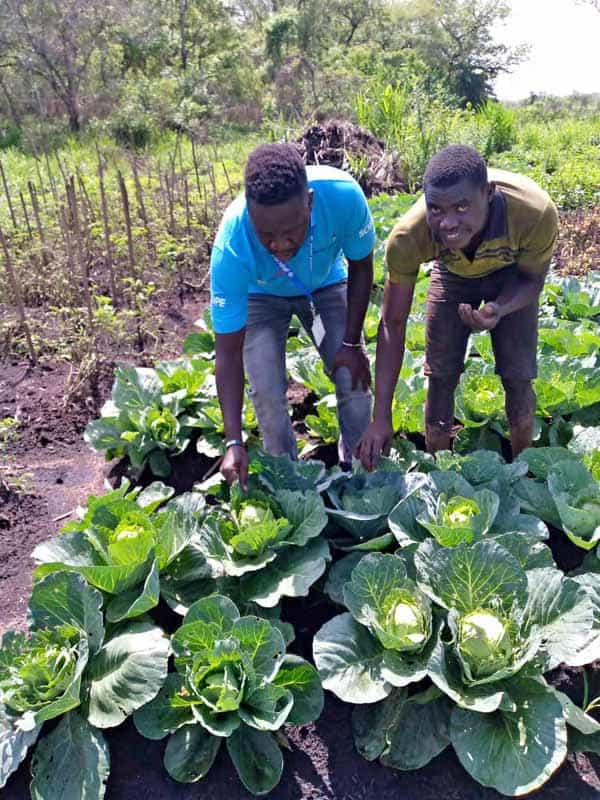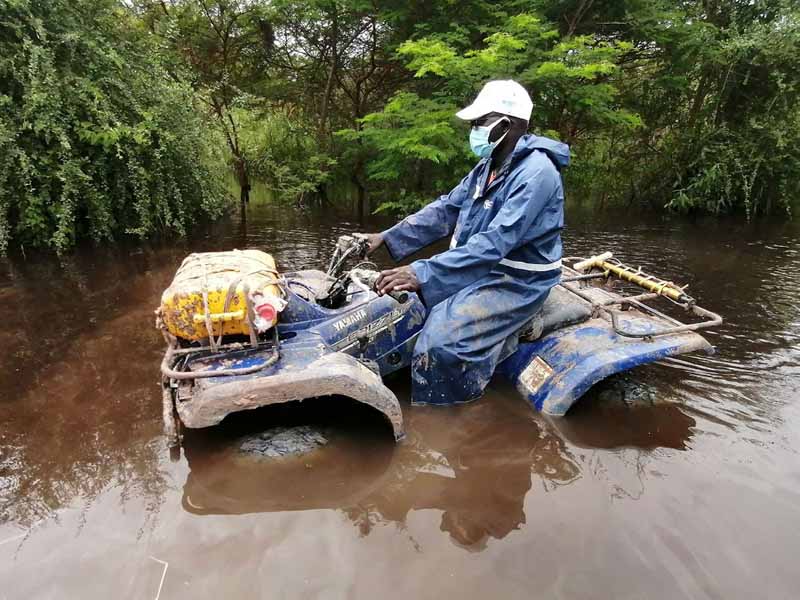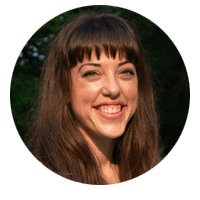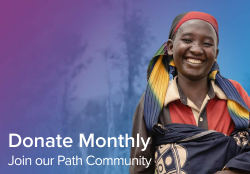Posts Tagged ‘Conflict’
4 Things to Know About Recent Conflict in Democratic Republic of the Congo
A new surge of conflict in Democratic Republic of the Congo is exacerbating one of the most neglected displacement crises in the world.
Recently, our team visited one of the large camps for internally displaced people (IDP) located on the outskirts of Goma. We spoke with pastors and members of World Relief’s Church Empowerment Zones who had been displaced.
We talked with women and youth, as well as church leaders and municipal authorities who are handling displacement issues. Everywhere we went, people expressed deep sorrow for the families who have lost loved ones due to the cholera epidemic in the camps, for the sisters and wives who have been raped amidst the conflict, for the thousands of children who cannot go to school and are stuck on the main roads with their families.
In all my years of working in the humanitarian and disaster response sector, I have witnessed terrible misery and despair. But what is currently happening in DR Congo is truly mind-boggling. For all those in these camps who have been displaced many times before, they are remembering past conflicts and displacements with great vividness.
While the crisis is heartbreaking, the long slow work of change continues taking shape. At World Relief we’re committed to assisting the local pastors, activists and community members who are fighting for change within their own communities.
Today, we’re sharing four things you need to know about the most recent conflict in Democratic Republic of the Congo and why it matters to World Relief. Let’s dive in.
1. The current conflict is centered in the North Kivu province, near Goma City.
In August 2022, clashes resumed between DR Congo’s military and rebel group M23. For the last decade, the rebel group had largely been held at bay. But the resurgence of violence triggered a new wave of displacement, violence and hunger in the country’s North Kivu province.
The cause of this conflict and the ongoing driving factors are incredibly complex and hotly debated. Since fighting began, the M23 has been active in a large portion of the North Kivu province, surrounding the capital of Goma. In February, the group advanced toward the city causing widespread panic in the region. While they did not reach the city and a ceasefire was put in place, many continue to live in fear and uncertainty.
2. More than 5.5 million people have been displaced as a result of the conflict.
Most of these families and individuals are now living in both formal and informal settlements for internally displaced people (IDPs).
Basic services including access to food and water, are scarce in camps. A recent report by the International Red Cross indicates that 93% of IDPs recently settled in camps in and around Goma are in dire need of essential household items like blankets, cookware and fabric.
Over the last year, education has been disrupted for more than 600,000 children in North Kivu.
Prior to this conflict, many of these individuals and families were living successful self-sustaining lives as farmers, traders, transporters, etc. But in the rush to escape the violence, they left everything behind and it’s unclear when it will be safe to return to their homes.
3. People in DR Congo desperately want peace.
While DR Congo is home to more than 100 armed groups operating in the eastern region, citizens are actively finding ways to come together and creatively pursue peace.
Artists in Goma are painting murals to amplify their call for peace and urge people to reject violence. Women across eastern DR Congo are mobilizing their communities, strengthening connections between local authorities and the communities in which they work, documenting human rights abuses and holding perpetrators accountable.
Though the loudest and most consistent narrative coming out of DR Congo is one of war and pain, the strength, resolve and collective push for development and healing must not be overlooked. In fact, much of World Relief’s work in the region is spearheaded by local pastors and community members who are working together to unite churches and build peace.
4. World Relief has been partnering with communities in DR Congo for more than two decades and staff are responding now.
Since 2001, World Relief has been working to address the root causes of conflict in Democratic Republic of the Congo and facilitate stability and healing in the country. Village Peace Committees were piloted in the early 2000s as part of an ongoing initiative to disrupt cycles of revenge that have the potential to escalate to violence by focusing on reconciliation and forgiveness.
Today, we’re responding in the hardest hit regions near Goma providing food and non-food items as well as hygiene and sanitation aid.
In partnership with local church groups, IDP committees and other NGOs, World Relief is identifying those facing the most acute hunger needs, prioritizing female-led households, people with disabilities and the elderly. Monthly food distributions, consisting of beans, maize, oil and salt, will provide for 100% of household emergency nutritional needs based on internationally-recognized standards.
Learn More
DR Congo faces one of the most complex and neglected humanitarian crises of our day. While this may not be making headline news, it’s affecting millions of people. Their stories matter and we believe it’s important to stay informed beyond the headlines.
Linked below are several stories from DR Congo and from Congolese refugees who are now living in the United States, as well as a few recommended resources for learning more about the history of DR Congo.
Stories from DR Congo:
- Change United to Bring Peace and Restoration
- World Relief DR Congo is Building Resilience from Ashes
- Global Peace Starts With Us
- Frontline Report: Democratic Republic of Congo
Congolese Refugee Stories
- Worth the Wait: A Story of Faith, Hope and Perseverance Despite the Odds
- From DRC to the 253: A Blacklisted Journalist Hasn’t Given Up Working or a Better Congo
- Rebuilding Welcome in Memphis
Learn More About DR Congo

Charles Franzén has been working in humanitarian and disaster response sector for more than 25 years. Prior to assuming the role of Humanitarian and Disaster Response Director at World Relief, he served as the Country Director in Democratic Republic of Congo for five years.
Through the Flood: How Conflict and Climate Change are Converging in South Sudan
Serving the most vulnerable often means accessing the furthest, hardest-to-reach places in order to meet those in greatest need. For Daniel Erwaga, it meant riding through waist-deep flood waters on a 4×4 all terrain vehicle to assist farmers whose fields had been flooded in South Sudan.
Over the last three years, record amounts of rainfall have led to increased flooding in South Sudan, affecting more than 835,000 people.
According to the United Nations High Commission for Refugees:
Climate change is driving more frequent and intense weather and climate extremes such as cyclones, floods and droughts, negatively impacting agricultural production, food and water resources, and people’s livelihoods. These effects can lead to conflict and humanitarian disasters and are increasingly contributing to displacement in different regions of the world.
Since gaining independence in 2011, South Sudan has struggled with ongoing civil conflict. This political instability has contributed to a food security crisis that today, is being aggravated all the more by climate instability.
Today, former World Relief staff, Daniel Erwaga, joins us from Juba to talk about how conflict and climate change are converging in South Sudan to increase the vulnerability of those already struggling with food insecurity.
Daniel shares his experience as a professional agriculturalist and South Sudanese citizen. Though the events discussed are occurring in South Sudan, we all have a role to play — as crises converge, the only way to move forward is together.
Read on to learn more and join us.
WR: Hi Daniel. Thanks for being with us today.
Daniel: Thank you. I’m so much pleased to have this interview.
WR: Could you start by telling us about the type of work you did for World Relief South Sudan?
Daniel: I started working with World Relief in 2017 until 2022 in March when my contract ended. I worked on emergency projects in partnership with OFDA and FAO. My role as an agriculturalist was to help people in Fangak and Koch communities understand the value of farming as a vocation. People here are pastoralists. They don’t know much about farming. I teach them everything from how to successfully grow crops all the way to running a business and selling their crops in the market.
WR: What prompted you to pursue a career as an agriculturalist?
Daniel: Of course. I’ve chosen this career based on my mentor – my father. He was also an agriculturalist. Back home, he had a kitchen garden and that kitchen garden impressed me. I told him I wanted to become an agriculturalist the same as him and he said, “No problem. You can do that.”
It is both love and a desire to have knowledge that pushed me to go into agriculture. When I was young, I thought to myself, “Of course, food is being produced by an agriculturalist. Why don’t you go and become a professional farmer because day and night, people are eating?” If I can go into agriculture, I can have a broader understanding of farming to help secure the nation, which is struggling with food insecurity.
WR: Can you share more about why this work is so important for communities in South Sudan?
Daniel: Yes. Currently, more than 8 million people are experiencing hunger in South Sudan. My philosophy is that I am helping them help themselves. Through our efforts, farmers are able to do for themselves because of the training and agronomic practices they learn. Of course, when there is conflict, people can’t cultivate the land, and often they move to another location. This mass migration into other territories can lead to more conflict and food shortages. And then there is the flood issue.

WR: How are you seeing the effects of climate change in the communities where you have worked?
Daniel: Climate change isn’t just in South Sudan, it’s everywhere. When there’s too much rain, it destroys crops from the gardens. I know you guys may not see it in the U.S., but here, we can also see the impact of climate change where animals die day and night because they don’t have anywhere to graze and they don’t have anywhere to stand. That’s part of it, but it also affects crops. You cannot harvest, of course, when your garden is flooded with water.
WR: In your experience, how have you seen conflict and climate change as being connected?
Daniel: Yes. In my own experience, climate change has nothing to do with conflict, but it also has something to do with conflict. Most of the conflict that happens in South Sudan is because of the power struggle. But on the other hand, climate change has contributed to the effects of the conflict.
Let’s take an example like Jonglei State. They’re pastoralists. When the floods came, they moved with their animals to the Equatorial states where the Equatorian people are farmers. When the people from Jonglei come with a large number of herds and cattle, they almost always bring conflict to the new community.
The pastoralists and farmers don’t communicate or collaborate with one another. So, when the pastoralists graze their animal in the farmer’s field, the animal will eat the crops of the farmer, and that’s where the conflict will come in. The flooding, which is caused as a result of climate change, also contributes to the conflict.
WR: There’s a photo of you that has become very popular at Word Relief. Can you tell us what was going on in that picture?
Daniel: You saw me on the convoy? Yes. It was last year in September. Some farmers had been calling me to go and check their gardens [which had been flooded]. I was riding in a truck, but I got stuck. Moving forward was a bit challenging. The place was flooded, so I could not move. I had to stop and assess how shallow the water was because the flood had covered the road, so there was nothing I could do. I could not go back and then I could not go forward.
That’s why I took the initiative of using the quad bike because the car could not access the road. I wanted to see how the garden had been flooded so I could give a report to see how those communities can be helped.

WR: If somebody’s garden is flooded, what kind of help is available to them through World Relief?
Daniel: First, you want to provide basic necessities like offering food because if the garden has been flooded, the person doesn’t expect to yield out of [a flooded garden]. You need to offer help. Then, if the flooding is not so much, you can dig a dyke, which can control the flood from entering into the garden. Those are the things I’ve been helping the farmers to do.
WR: Does South Sudan usually have a rainy season and a dry season, and has that changed?
Daniel: Yes. We have two seasons here, rain season and then dry season. As I’m speaking now, people are complaining because people are sleeping over the water. As a result, there is mass migration. People are moving out to higher elevated ground because of the flood.* Currently, we are now in the rainy season.
WR: What challenges does it create when so many people have to move to a new place because of flooding?
Daniel: There are a lot of challenges, one of which is shelter because when you migrate to a new location, you may find it hard for you to find shelter. Finding a place to sleep is a problem. Also toilets. A lot of disease can come when people don’t have a place to use the toilet. Also, as I said, there is even community conflict as a result of climate change and migration. People from Jonglei State are also migrating to Equatorian states where the flooding is less. They’re coming with their animals, and then the animals are eating another farmer’s crops, so there is conflict when this happens.
WR: At World Relief, we’ve been talking a lot about COVID, conflict and climate change. What do you think the Christian community can do to help with these crises?
Daniel: Christian community can play a big role in addressing crises like COVID-19. First, they can establish psychosocial support structures in the community to help people who are traumatized, who are affected with COVID-19. We can also build on that by procuring face masks and creating awareness.
Now, when it comes to conflict, the Christian community can promote peace and reconciliation and dialogue forums to address the issue of conflict. Christian community can also provide training in peace-making methodology to address the issue of conflict. These are things World Relief does well in engaging church leaders in the process.
The Christian community can respond differently than other individuals or governing bodies because the church leader is listened to and is trusted by members of the community.
WR: What do you want the global community to know about South Sudan?
Daniel: Of course, most of the global community doesn’t know about South Sudan. South Sudan is the world’s newest nation, gaining independence on July 9th of 2011.
Since gaining independence, conflict has renewed in both 2013 and 2016, and the country has suffered severe flooding and drought. Most of the communities are suffering. As I’m speaking, they need much support to build their livelihood and then to recover from the shock of what they’re going through. You can convey our message to the global community so that they know there’s a country, which is so new and these people are suffering. They’re more vulnerable because communities are highly prone to climate-related impacts and a loss of livelihood because of the flooding.
WR: What would you say is your biggest prayer right now for South Sudan?
Daniel: My biggest prayer for South Sudan is for our country’s leadership so that whatever they’re doing, they are first thinking of the people who are suffering. My biggest prayer for the leaders is that they have a heart of forgiving one another because without peace, we cannot do anything. I do pray for that day and night.
WR: Absolutely. We’ll be praying for that too. Similarly, what do you hope for South Sudan?
Daniel: Personally, I hope for the best, a brighter future for South Sudan. In the future, our country is going to be more stabilized and is going to be a peaceful country. Of course, with support from the global community, I know things will improve well. I have hope for a better future for South Sudanese.
In the face of unprecedented challenges, the only way forward is together. Give today and help us reach more people, in more communities, with more resources than we ever dreamed possible.
*South Sudan is home to the Sudd, the world’s largest wetland covering more than 35,000 square miles. While the Sudd is prone to annual flooding, increased rains have affected the length and intensity of the floods. What’s more, the Nile river feeds into the Sudd from Uganda. A prolonged rainy season in Uganda increases the water levels of the Nile, which can lead to more flooding in South Sudan.

Rachel Clair is a Content Manager at World Relief. Alongside an amazing team of marketing colleagues, she manages the curation and creation of written and multi-media content for World Relief’s global platforms. With more than 10 years of experience creating content for churches and non-profits, she is passionate about developing content that challenges both individuals and communities to lean into all of whom God created them to be. She holds a BFA from Stephens College and is currently participating in a spiritual formation cohort through the Transforming Center in Wheaton, IL.
Church Engagement Is the Best Solution to Humanitarian Crises
Today is World Humanitarian Day. It’s a day upon which we honor humanitarian workers around the globe, and a day on which we seek to reflect on how we, as global citizens, might respond better, smarter and more effectively to the hundreds of humanitarian crises around our world.
Today, there are over 2 billion people living in fragile conflict zones, driving 80% of the world’s humanitarian needs. These complex crises, often driven by tensions between ethnic, tribal and political groups, cause violence and instability that force people from their homes and prevent access to food, water, health services and shelter. A recent report found that the number of people internally displaced by conflict around the world is at an all-time high, at 41.3 million. In 2018 alone, conflict forced more than 10 million people to flee their homes.
Many of these conflicts are in Africa. The Darfur region in western Sudan, for example, has been in an ongoing state of emergency since 2003. Darfur’s population suffers from poor health and nutrition systems and frequent disease outbreaks. Fighting over scarce resources in this region is made worse by overcrowding and drought. In South Sudan, attacks on civilians, sexual violence against women and girls and forced recruitment of youth into armed groups are daily occurrences in the world’s newest nation. And in the Democratic Republic of Congo, ongoing conflict has left more than 2 million babies and toddlers suffering from severe malnutrition.
Poverty, and the conflict that often results, is rampant in many parts of our world. So today, as we reflect on the thousands of humanitarian efforts around the world, we ask ourselves, how can we reduce this suffering? How can we even make a dent in these great needs? How can people on the other side of the world – with little cultural knowledge of these places – make a lasting impact?
The short answer is, we can’t…at least not in the ways we’ve traditionally tried. Barreling in with troops, or with thousands of eager, well-intentioned philanthropic volunteers, is not the answer and may even exacerbate the problem. While Western organizations can play an important part in providing emergency health, water and sanitation services, these are merely short-term solutions to long-term problems.
This is why we believe that recovery and development have to start on the ground with local communities, and that the best way to use our resources to achieve lasting change is to effectively train and equip local churches and community leaders to act. For years, World Relief has been successfully training local churches to direct and lead change in their communities. Through programs like agricultural trainings, Savings for Life groups and Village Peace Committees, local churches are being empowered to serve their communities and bring peace to their nations.

Now, we acknowledge that the church has not always lived up to its calling and potential. History has shown us that as much as the church can transform communities for the better, it can also be used to tear them apart. Yet we have seen what happens when the church says ‘yes’ to God’s calling and steps fully into its God-given role, caring for the most vulnerable around the world. It is for precisely these reasons that we believe, in the face of some of the worst humanitarian crises in the world, the church can be the solution, and that when the church is mobilized to achieve its full potential, it has the power to change the world.
We believe this because:
The local church is God’s plan to reveal his mercy, compassion and truth to people around the world.
The local church is the largest social network on the planet and has the ability, authority and permanency to do far more than any government institution or non-profit organization could.
The local church is led by trusted community leaders — those with an inside voice and understanding that no outside organization can bring.
The local church has the influence and moral authority to shape behaviors rooted in biblical values of love, compassion and justice.
The local church offers the greatest hope of reconciliation between classes, tribes, ethnicities and political parties, unifying people under a common identity in Christ.
The local church can restore dignity and bring hope to the suffering, forgotten and marginalized by reaching out to the most vulnerable in its community and answering God’s call to love.
The local church is empowered by the Holy Spirit to do more than human wisdom and efforts could ever possibly accomplish alone.
Local churches can be the foundation of sustainable change. When we partner with them, we have the power to break the vicious cycles of conflict and poverty that endanger the lives of millions of people. On World Humanitarian Day, let us join together to continue empowering the local church to serve the most vulnerable.

Tim Breene served on the World Relief Board from 2010 to 2015 before assuming the role of CEO from 2016-2020. Tim’s business career has spanned nearly 40 years with organizations like McKinsey, and Accenture where he was the Corporate Development Officer and Founder and Chief Executive of Accenture Interactive. Tim is the co-author of Jumping the S-Curve, published by Harvard Publishing. Tim and his wife Michele, a longtime supporter of World Relief, have a wealth of experience working with Christian leaders in the United States and around the world.

Celebrating MLK’s Legacy
“I refuse to accept the view that mankind is so tragically bound to the starless midnight of racism and war that the bright daybreak of peace and brotherhood can never become a reality…I believe that unarmed truth and unconditional love will have the final word in reality.” – Dr. Martin Luther King, Jr.
War. Poverty. Hunger. Disease. Slavery. The times have changed since Dr. Martin Luther King, Jr. accepted the Nobel Peace Prize in 1964, but many of the same injustices remain. We read news headlines about conflict altering the lives of millions. More than 1 billion people in the world live on less than $1.25 a day. It’s estimated that 805 million don’t have enough to eat on a regular basis. 1.5 million children under the age of 5 died from vaccine-preventable diseases in 2008. And more than 20 million people are held in slavery today.
These statistics seem grim, but as we remember MLK’s legacy this month, we also shed light on the hope that is changing the atmosphere and are surrounded by stories of peace and brotherhood.
In word and deed, World Relief staff and volunteers work through local churches around the globe to make sure this hope is tangible. Whether it’s training local church leaders to peacefully resolve conflicts within their community in places like war-torn Democratic Republic of Congo or teaching farmers in Kenya new techniques that provide food and a sustainable income or helping survivors of human trafficking here in the US, we’re seeing justice spread like wildfire.
There is still much to be done, but unarmed truth and unconditional love are in our midst and the movement for justice that began long ago is carrying on to completion.




